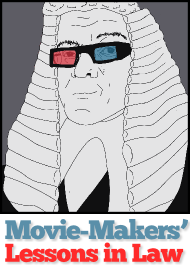Law lessons from movie makers: The lady from Shanghai (1948) – Prof. Penny Cooper
 After nine reviews I can choose only one more and it’s not easy to leave out a movie like To Kill a Mockingbird (1962). Arguably Mockingbird is a better movie – it is certainly better known – but Shanghai is often overlooked. Let me introduce you to a movie that was panned by some critics at the time but is now more widely regarded as a masterpiece.
After nine reviews I can choose only one more and it’s not easy to leave out a movie like To Kill a Mockingbird (1962). Arguably Mockingbird is a better movie – it is certainly better known – but Shanghai is often overlooked. Let me introduce you to a movie that was panned by some critics at the time but is now more widely regarded as a masterpiece.
Orson Welles directed and starred in this epic with his wife (estranged by the time of the movie) Rita Hayworth. Hayworth is drop-dead gorgeous, literally. Her trademark long, red hair was cropped and bleached blond for the part. She is the dangerous, bewitching Elsa, miserably married to Arthur Bannister, the filthy rich and self-styled ‘greatest living trial lawyer’.
Michael (Welles) is smitten from the moment he sees Elsa taking a carriage ride through Central Park in New York. He rescues her from an attack by robbers and she repays him by inviting her to help sail her husband’s sumptuous yacht through the Panama Canal to San Francisco. Michael is arrogant, independent and senses danger but eventually, after several drinks with Arthur Bannister (Everett Sloane), he agrees to sail with them. And what a mistake that was. Will he ‘grow old and forget her or die trying’?
This film is about greed for money and sex and it eventually lands Michael, Elsa and Arthur in court. Arthur is undoubtedly a fine trial strategist and the court scene is well-written; even the farcical part where Bannister cross-examines himself actually works.
The movie plot exemplifies Michael’s philosophy on life: Everybody is somebody’s fool. Watch it because Welles was a cinematic genius, the plot has multiple twists and turns, the scenery is gorgeous (Oh to sail to Acapulco), the yacht ‘Zaca’ was really owned by Hollywood’s greatest swashbuckler Errol Flynn, and Hayworth is utterly beguiling. Then reflect on the interpretation of ‘corpus delicti’; was it really that case that a person could not be convicted of murder if there was no corpse?
‘It’s a wrap’ as they say
There are many other movies that might have made it onto the list and there are the TV courtroom dramas which deserve a list of their own. I have a very soft spot for Granada’s Crown Court of the 1970s as it played no small part in my decision to become a barrister. Decades later I have found CBS’s JAG compelling. More recently I enjoyed BBC’s Garrow’s Law, and rounded off TV viewing by browsing copies of actual Old Bailey records of Garrow cases from the 1780’s.
Whilst reviewing these movies I discovered that the University of San Francisco’s Picturing Justice site publishes ‘over 300 short articles on the intersection between law and lawyers…and popular culture’. Asimow and Bergman’s book ‘Reel Justice: The Courtroom Goes to the Movies’ (1996) reviews movies and also gives them a one to four gavel rating.
As you watch these ten courtroom movies, reflect on the art of lawyering. Enjoy these movies for the entertainment that they give and then let them stimulate your legal mind. Remember too that there is nothing quite as fascinating as the real thing. In Famous Trials (1986) John Mortimer QC, the creator of Rumpole of the Bailey, said
‘High among the great British contributions to world civilization, the plays of Shakespeare, the full breakfast, the herbaceous border and the presumption of innocence, must rank our considerable achievement in having produced most of the best murder trials in the long history of crime’.
The studios make the movies but the courts still produce the originals.
Penny Cooper
The author would like to say a big thank you to the family and friends who watched with her – it would not have been the same without you.
© Penny Cooper, 18 November 2013
